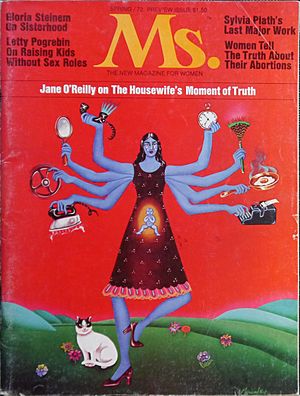Ms. (magazine) facts for kids
 |
|

The preview issue of Ms., Spring 1972
|
|
| Executive Editor | Katherine Spillar |
|---|---|
| Categories | Feminism |
| Frequency | Quarterly |
| Circulation | 110,000 |
| Publisher | Liberty Media for Women, LLC |
| First issue | December 1971 |
| Company | Feminist Majority Foundation |
| Country | United States |
| Based in | Arlington County, Virginia, U.S. |
| Language | English |
| ISSN | 0047-8318 |
Ms. is an American liberal feminist magazine. It was started in 1971 by journalist and activist Gloria Steinem. It was the first national feminist magazine in the United States.
The first issue of Ms. came out in January 1972. It was funded by New York magazine editor Clay Felker. From 1972 to 1987, it was published every month. Now, it comes out four times a year. Since 2001, the Feminist Majority Foundation has published the magazine.
Contents
How Ms. Magazine Started
The First Ms. Cover
The first look at Ms. magazine was in December 1971. It was part of New York magazine. The cover showed a drawing of the Hindu goddess Kali. She was pregnant and had eight arms holding everyday items. These items included a clock, a skillet, and a telephone.
This first issue sold 300,000 copies in just three days. It also got 26,000 orders for subscriptions very quickly. Gloria Steinem liked this cover. She felt it showed a woman balancing many parts of life. This was a main idea for Ms. magazine. The cover also used a Hindu goddess to show that the magazine was for all women.
Why Ms. Magazine Was Created
Ms. magazine was meant to be a voice for women, created by women. Before Ms., women's voices were often missing from major media. The first independent issue of Ms. talked about removing sexist words from the English language. It also had articles to help women stand up against old social rules.
Gloria Steinem, a co-founder, explained why she started the magazine. She said there was no magazine for women that was controlled by women. Steinem wanted a magazine that discussed topics important to modern women. She did not want it to focus only on fashion or housekeeping.
The magazine's creators hoped readers would get involved. Many readers sent letters to the editors. They shared how important Ms. magazine was to them personally.
Choosing the Name Ms.
Steinem said they first thought of calling it Sojourner, after Sojourner Truth. But that sounded like a travel magazine. Then they thought of Sisters, but that sounded like a religious magazine. They chose Ms. because it was symbolic and short.
At that time, "Ms." was a new way to address women. It was an alternative to "Miss" or "Mrs." It did not show if a woman was married or not. Sheila Michaels helped make "Ms." more known. A friend of Steinem heard Michaels suggest "Ms." on a radio show. This friend then suggested it as a title for the new magazine.
Wonder Woman on the Cover
Gloria Steinem put Wonder Woman on the cover of the first independent issue of Ms. in July 1972. This issue also had an article praising the character. Steinem was upset because Wonder Woman's powers had been taken away in recent comic books.
The author Samuel R. Delany wrote two Wonder Woman comic books in 1972. During this time, Wonder Woman became a secret agent without her powers. Steinem protested this change. Her efforts helped bring back Wonder Woman's powers and classic costume in 1973.
The Ms. cover with Wonder Woman was titled "Wonder Woman For President." Steinem wanted to show Wonder Woman as a feminist hero. She felt that newer images of Wonder Woman in the 1960s made her seem like an object. By putting Wonder Woman on the cover, Steinem helped convince DC Comics to bring back her truth lasso, bracelets, and origin story.
The Ms. cover wanted to show Wonder Woman's compassion and belief in justice. Some people supported Wonder Woman as a feminist icon. Others thought Ms. should not feature a woman with "superhuman" qualities. However, the Ms. editors worried about putting real female public figures on early covers. They did not want to make them the only symbol of the feminist movement.
Magazine Content and Themes
The first cover story for Ms. magazine was "The Housewife's Moment of Truth" by Jane O'Reilly. This article talked about feminist strength. It also discussed fighting against the pressure on wives in society and at home. The article introduced the idea of "click!" This was the moment a woman realized she could fight against unfair demands.
In January 1973, the cover featured Shirley Chisholm and Sissy Farenthold. The title was "The Ticket That Might Have Been."
From 1974 to 1977, Ms. worked with public broadcasting. They created a TV show called Woman Alive!. The show was like the magazine. It had short documentaries by women filmmakers, interviews, and entertainment.
In 1976, Ms. was the first national magazine to talk about domestic violence. The cover photo showed a woman with a bruised face.
Ms. magazine also challenged the holiday phrase "Peace on earth, good will to men." They changed it to "Peace on earth, good will to people." In its early years, the December cover showed this new holiday message.
Over its history, the magazine has featured articles by and about many important women and men. These include leaders in business, politics, and journalism. The magazine's investigative reporting uncovered important stories. These included articles on overseas sweatshops, the wage gap, and the glass ceiling.
Ms. magazine often attracted "cultural" feminists. These were people interested in changing deep-rooted gender norms in American culture. The editors of Ms. were activists, writers, and college graduates. They aimed to represent "female universality." This meant including all women, no matter their background, race, or beliefs.
Ms. Magazine Since 1987
In 1987, an Australian media company bought Ms. In 1989, American feminists bought it back. They started publishing the magazine without ads.
Robin Morgan and Marcia Ann Gillespie were editors-in-chief. Gillespie was the first African-American woman to lead Ms. The magazine became known for showing how advertisers often control content in women's magazines.
In 1998, Gloria Steinem and other women investors created Liberty Media. They made the magazine independent. It stayed ad-free and won several awards. In 2001, the Feminist Majority Foundation bought the magazine. They moved its main office from New York to Los Angeles. The magazine now comes out quarterly.
In 2005, Ms. was nominated for a National Magazine Award. This was for Martha Mendoza's article "Between a Woman and Her Doctor."
Later Content and Anniversaries
In 2017, Ms. celebrated its 45th anniversary. To honor this, Ms. referred to its first issue from 1972. That issue had Wonder Woman on the cover. This choice was made because Wonder Woman believes in "sisterhood and equality." Ms. says this is a key value for feminist beliefs, both then and now.
Ms. Magazine and Women of Color
Ms. and Black Women
Gloria Steinem was inspired by many women of color in her activism. She worked with Flo Kennedy and Shirley Chisholm to support women's rights. Steinem founded Ms. magazine with Dorothy Pitman Hughes. Hughes was involved in child-welfare activism and the Civil Rights Movement. In 1973, Ms. featured Shirley Chisholm on a cover.
However, Ms. magazine was also criticized for not showing enough diversity. This was especially true in the late 1980s. In 1986, author Alice Walker stopped writing for Ms.. She said there was a lack of diversity on the magazine's covers and in its articles about women of color. The editors of Ms. admit that their publications sometimes seemed "elitist." But they say the content was always meant to include everyone.
From 1993 to 2001, Marcia Ann Gillespie was editor. During her time, the magazine greatly increased the voices and views of women of color. It also included more diverse feminists and opinions.
As of 2020, Ms. magazine still features the work of Black women. For example, Janell Hobson writes the Black Feminist in Public series. This series highlights how different parts of a person's identity, like race and gender, connect in the media.
Ms. and Indigenous Women
Steinem was also greatly influenced by Wilma Mankiller. Mankiller was a member of the Cherokee Nation. She joined the board of the Ms. Foundation for Women in 1973. Ms. named her Woman of the Year in 1987. Steinem and Mankiller were friends and worked together. Mankiller focused on the rights of indigenous women.
The magazine has increased its coverage of issues affecting indigenous communities. For example, Ms. reported on new laws to protect indigenous women. These laws include the Savannah Act and the Not Invisible Act.
Advertising Rules
In 2008, the American Jewish Congress said Ms. magazine refused their ad. The ad honored three important Israeli women: Dorit Beinisch, Tzipi Livni, and Dalia Itzik.
Katherine Spillar, the executive editor of Ms., responded to these criticisms. She said the magazine's policy is to accept only "mission-driven advertisements." These ads come from non-profit, non-political groups. She felt the proposed ad could seem to favor certain political parties in Israel. It also implied that women in Israel hold equal power with men. Spillar stated that the magazine had covered Israeli feminist movements and women leaders many times.
Writers
Some people who have written for Ms. include:
- Angela Davis
- Barbara Ehrenreich
- Susan Faludi
- Alice Walker
- Marcia Gillespie
- Jane O'Reilly
- Susan Braudy
- Letty Cottin Pogrebin
Images for kids
See also
 In Spanish: Ms. (revista) para niños
In Spanish: Ms. (revista) para niños



